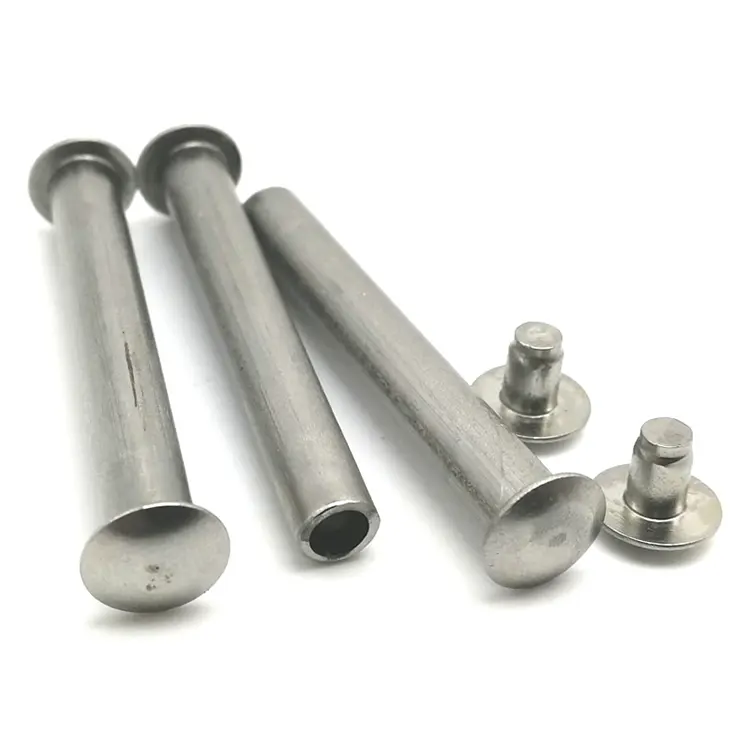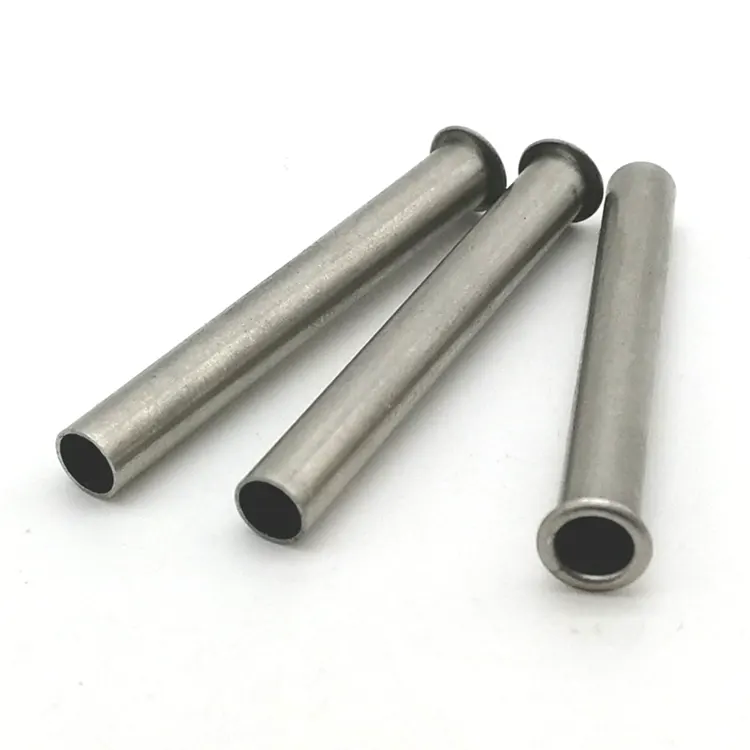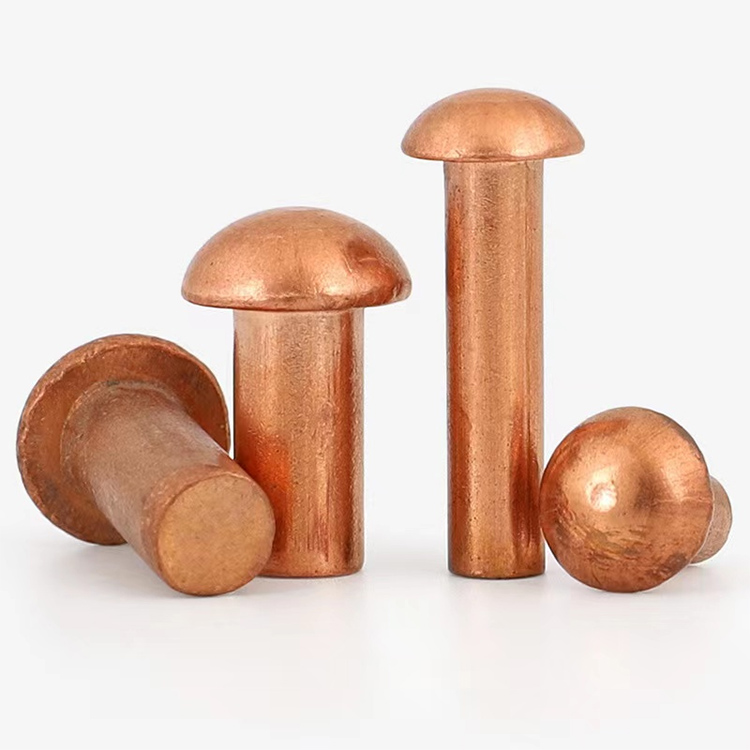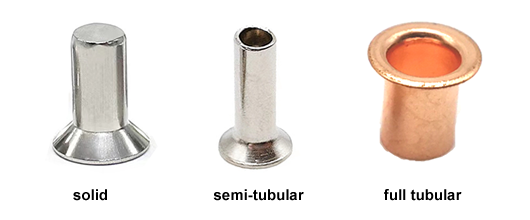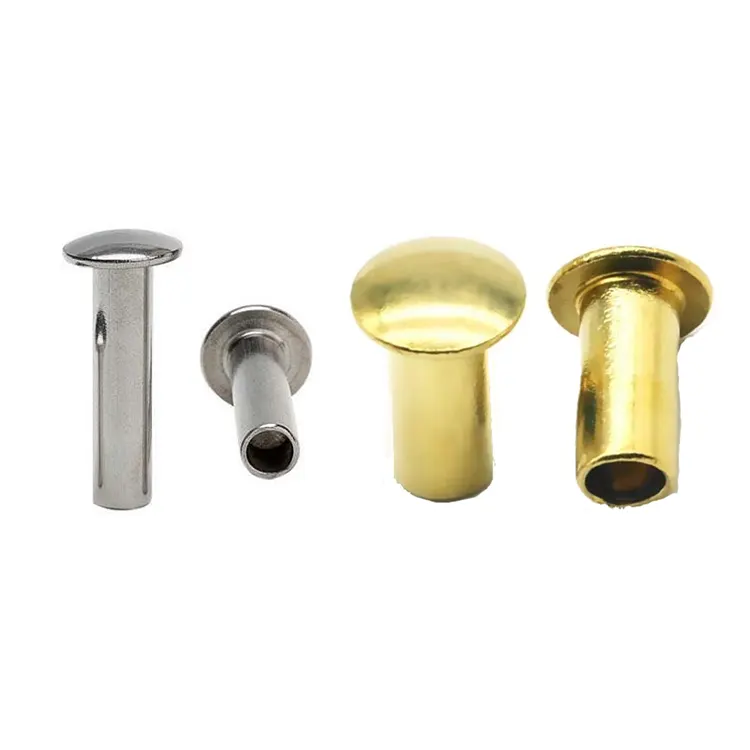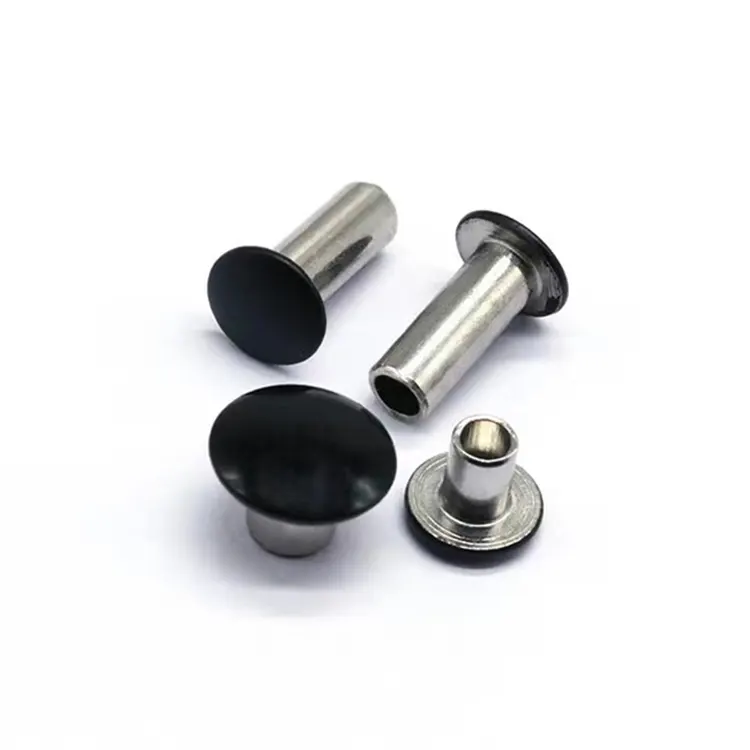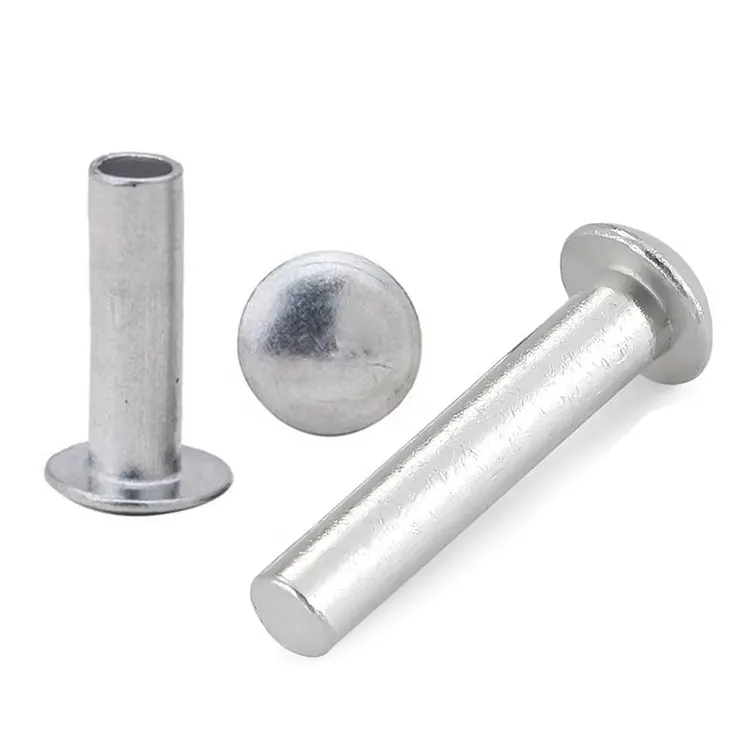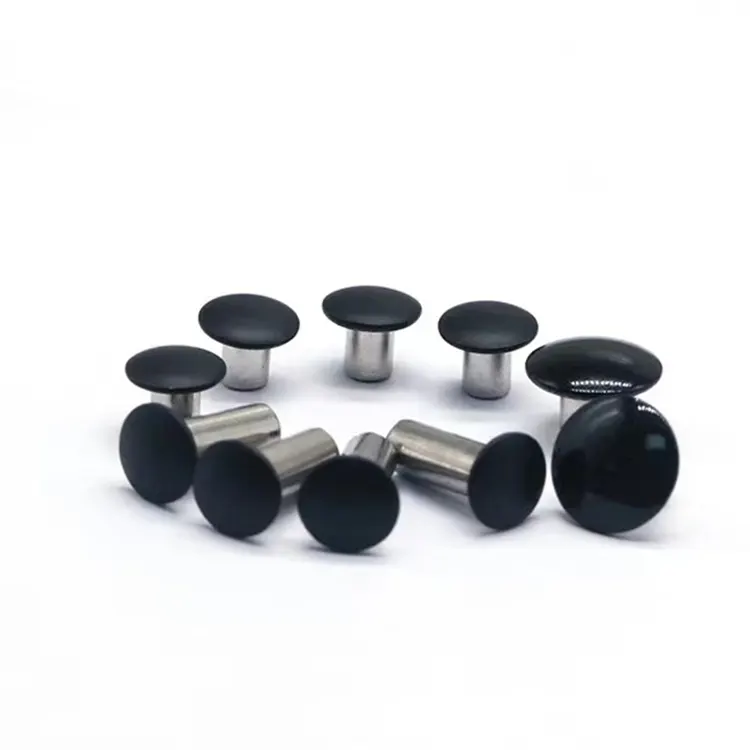Nity
As one of professional manufacturer in China, Notin would like to provide you Rivets. And we will offer you the best after-sale service and timely delivery.
What is a rivet?
A rivet is a permanent mechanical fastener used to join two or more materials. Rivets work by inserting a metal pin into an aligned hole and deforming the end, creating a strong, secure, and durable connection. Unlike temporary fasteners like screws, rivets do not rely on threads, but instead form a permanent connection, making them ideal for applications requiring high strength, durability, and vibration resistance.
Classification of Rivets
Rivets are typically categorized by head shape, degree of hollowness, or material.
Based on head shape, rivets can be classified as flat head rivets, round head rivets, countersunk head rivets, mushroom head rivets, universal head rivets, truss head rivets, etc.

Based on degree of hollowness, rivets can be classified as solid rivets, semi-tubular rivets, or full tubular rivets.
Based on material, rivets can be classified as brass rivets, stainless steel rivets, steel rivets, aluminum rivets, copper rivets, etc.
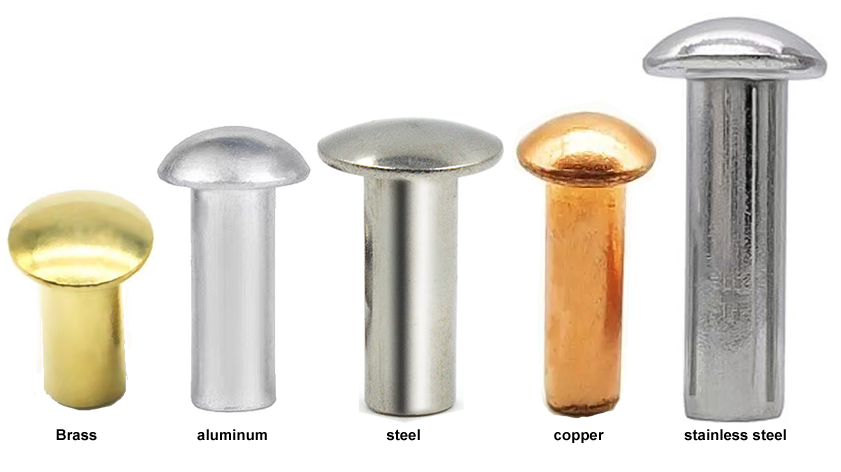
What surface finishes are available for rivets?
Rivet surfaces are typically treated with rust-proofing treatments, primarily electroplating, including zinc plating, nickel plating, chrome plating, tin plating, gold plating, and silver plating. Electroplating is a common rust-proofing method for rivets. It applies a layer of plating to the rivet surface through physical or chemical methods. The plating effectively prevents corrosion and rust, while also providing a certain aesthetic effect.
Another special surface treatment method is head coating. Head coating is performed after the rivet is electroplated. This allows for a variety of colors on the rivet head, achieving an aesthetically pleasing finish.
Aluminum rivets cannot be electroplated, but they can be anodized. Anodizing also allows for a variety of color options, but the unit price is higher than electroplating.
Rust-proofing the rivet surface is crucial, effectively extending the rivet's service life and ensuring a secure connection. Different rust-proofing methods are suitable for different environments and applications, so the choice should be tailored to the specific situation.
- View as
Nity półpuste
Nuote Metals to profesjonalny producent nitów z siedzibą w Dongguan w Chinach, przemysłowo rozwiniętym mieście zapewniającym dogodny transport i kompleksową gamę obróbki powierzchni. Nity półdrążone to powszechnie stosowane elementy złączne charakteryzujące się wydrążonym przekrojem na trzpieniu. Taka konstrukcja pozwala im lepiej dostosować się do odkształceń łączonych materiałów podczas procesu nitowania, poprawiając tym samym wytrzymałość i niezawodność połączenia. Nity półpuste znajdują szerokie zastosowanie w przemyśle motoryzacyjnym, lotniczym, stoczniowym, a także przy montażu elektroniki i sprzętu AGD.
Czytaj więcejWyślij zapytanieNity z łbem okrągłym
Nity z łbem okrągłym charakteryzują się unikalną konstrukcją łba z półkolistym występem. Struktura ta skutecznie rozkłada naprężenia, gdy nit jest poddawany działaniu siły, zwiększając stabilność połączenia. Podniesiona głowica ułatwia również pozycjonowanie i wyrównywanie podczas instalacji. Co więcej, nity z łbem okrągłym zapewniają doskonałą odporność na korozję i zmęczenie, utrzymując stabilną wydajność w czasie w trudnych warunkach. Szukasz nitów wyprodukowanych w Chinach? Zachęcamy do kontaktu z Nuote Metals, mamy ponad 10-letnie doświadczenie w pracy nad nitami.
Czytaj więcejWyślij zapytanieNity malowane proszkowo
Nity kolorowe, zwane również nitami malowanymi proszkowo, są pokrywane powłoką proszkową na łbie nitu w procesie malowania natryskowego w wysokiej temperaturze. Farba jest równomiernie suszona, aby zapewnić nieblaknące wykończenie. Ten rodzaj nitu wymaga dużej umiejętności wypalania lakieru i precyzyjnego dopasowania kolorystycznego. Po nitowaniu tworzy spójny i piękny kolor, w pełni realizując swój efekt dekoracyjny.
Czytaj więcejWyślij zapytanieNity z łbem płaskim
Nity z łbem stożkowym to elementy mechaniczne służące do mocowania lub łączenia materiałów metalowych. Są szeroko stosowane w produkcji przemysłowej, produkcji maszyn, naprawie samochodów i innych dziedzinach. Funkcją nitu jest włożenie rurki nitu w dwa łączone kawałki metalu. Kształt łba nitu i przekroju rury ściskają nit, tworząc szczelne połączenie. Nuote Metals specjalizuje się w produkcji nitów z łbem stożkowym. Dysponujemy ponad 40 maszynami do kucia na zimno i tysiącami matryc, a dzienna zdolność produkcyjna sięga nawet 10 milionów nitów. Przyjmujemy zamówienia niestandardowe na podstawie rysunków i próbek.
Czytaj więcejWyślij zapytanieMalowane nity
Nity malowane z malowanym łbem charakteryzują się dużą odpornością na korozję. Warstwa farby, zwykle o grubości 15-25 mikronów, skutecznie izoluje je od wilgoci i substancji chemicznych. Testy w mgle solnej pokazują, że nity malowane są odporne na rdzę przez ponad 500 godzin, czyli trzy razy dłużej niż nity niepowlekane. Nuote Metals specjalizuje się w tego rodzaju nitach, jesteśmy zlokalizowani w Dongguan w Chinach.
Czytaj więcejWyślij zapytanieNity grzybkowe
Nazwa nitu grzybkowego pochodzi od jego wyglądu i cech konstrukcyjnych. Jeden koniec nitu ma kształt grzybka i jest stosunkowo szeroki, co zapewnia lepszą powierzchnię dociskową i efekt estetyczny. Nity półrurowe z łbem grzybkowym mają na drugim końcu półpustą konstrukcję. Podczas instalacji stosuje się specjalne narzędzie do rozszerzania pustej części w celu utworzenia bezpiecznego połączenia. Taka konstrukcja pozwala nitowi dostosować się do różnych grubości materiału po zamontowaniu, zachowując jednocześnie schludne i estetyczne połączenie. Dostępne są również nity z pełnym łbem grzybkowym, które są nitowane śrubowo, tworząc łeb w kształcie grzybka na końcu, tworząc połączenie, które jest zarówno estetyczne, jak i bezpieczne.
Czytaj więcejWyślij zapytanieWhat are the advantages of rivets over other fasteners?
1. Ease of Installation
Rivets are fast to install, and even fully automated for high-volume applications, resulting in a simple and efficient operation process.
2. Connection Reliability
The riveting process is standardized, with strict quality control, resulting in highly stable connections. Visual inspection allows for quick verification of connection quality.
3. Vibration and Impact Resistance
Rivets connect through deformation or interference fit, providing strong clamping force and excellent vibration resistance, capable of withstanding vibration and shock.
4. Low Cost
Rivets are easy to install and can be fully automated, saving significant labor costs.
What are the advantages and disadvantages of rivets made of different materials?
Aluminum Rivets
Advantages: Lightweight, reduces overall product weight, low cost, suitable for general civilian applications.
Disadvantages: Low tensile and shear strength, unsuitable for high-strength workpieces, prone to electrochemical corrosion when in contact with metals such as stainless steel.
Stainless Steel Rivets
Advantages: Strong corrosion resistance, high hardness, suitable for high-strength workpieces (such as marine equipment)
Disadvantages: Higher cost, typically more expensive than aluminum rivets of the same specification.
Brass and Copper Rivets
Advantages: Excellent conductivity (such as connecting electronic components), good corrosion resistance.
Disadvantages: Higher cost, more difficult to process.
Steel Rivets
Advantages: High hardness, high connection reliability, and wide applicability.
Disadvantages: Compared to other materials, iron rivets are more prone to rusting.
What are the main applications of rivets?
Rivets have a wide range of uses, from small items like a pair of scissors to large items like airplanes and ships, as well as in high-precision medical applications.
Industrial Manufacturing
Rivets are used in a wide variety of industrial fields, wherever there is a need to connect two or more materials.
Electronics
Rivets secure heat sinks and chips, providing both vibration damping and noise reduction, and are widely used in the cooling systems of electronic products such as computers and mobile phones.
Automotive
Rivets are widely used to connect components of automobile bodies and chassis, such as doors and hoods. Their lightweight and corrosion-resistant properties make them an indispensable joining method in automotive manufacturing.
Aerospace
In aircraft manufacturing, rivets are used to connect different fuselage components, such as wings and tailplanes. Millions of rivets create high-strength, corrosion-resistant joints. Aluminum and titanium alloy rivets are often used to connect components of corresponding materials, ensuring stability in extreme environments.
Rivets are used everywhere. The above examples only represent a small number of their applications. We see rivets everywhere in our daily lives, such as on scissors, folding beds, and strollers etc. Rivets can be customized to different sizes and materials depending on the application.
Nuote Metals has specialized in the rivet industry for over a decade. Our factory is located in Dongguan, a city known as the "World Factory," a city with a developed industry and convenient transportation. This allows us to respond quickly when acquiring raw materials and supporting surface treatments, meeting our customers' needs for quick access to samples and bulk orders. We produce 10 million rivets daily and have molds of various specifications, allowing us to produce rivets as small as 0.8mm and as large as 10mm. We welcome your inquiries and visits.

